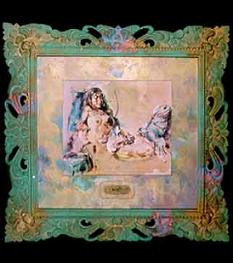Bali is an island of artists, or so it might seem at times. One of the famous foreign artists to live in Bali was Antonio Blanco, or ‘the Maestro’ as he liked to be called.
Early life
Don Antonio Blanco hailed from Catalonia is Spain, born on September 15, 1911 in the Ermita district of Manila. Blanco was educated at the American Central School in Manila. During his high school years he loved the arts, literature and language classes but struggled in scientific subjects. No wonder he spoke six languages – Spanish, French, English, Tagalog, Indonesian and a bit of Balinese.
Education
 After completing high school in Manila, Blanco studied at the National Academy of Art in New York under Sidney Dickinson. Even during those early formative years, Blanco concentrated on the human form, fascinated by the female body more than any other subject matter. After finishing his study in New York, he travelled extensively throughout the world to further his studies and ignite his vagabond spirit. Finally he landed in Bali in 1952. Later the King of Ubud granted him 2 hectares of land on the spot where 2 streams come together creating the Campuhan River.
After completing high school in Manila, Blanco studied at the National Academy of Art in New York under Sidney Dickinson. Even during those early formative years, Blanco concentrated on the human form, fascinated by the female body more than any other subject matter. After finishing his study in New York, he travelled extensively throughout the world to further his studies and ignite his vagabond spirit. Finally he landed in Bali in 1952. Later the King of Ubud granted him 2 hectares of land on the spot where 2 streams come together creating the Campuhan River.
Family
After marrying a famous Balinese dancer, Ni Ronji, the Maestro lived in Bali with his 4 children,
Tjempaka, Mario, Orchid and Maha Devi. The family home is a palatial hilltop house with a thatched bamboo roof, stone carvings, gilded statues and lush gardens. After a brief trip to the United States where Blanco secured many new collectors, the couple didn’t leave their fantasy home at all.
The artist
Blanco lived and worked in his magical hilltop home till his death in 1999, creating feverishly his
fantasy portraits of beautiful women. Surrounded by lush gardens, rice fields and a Banyan tree
standing over his family’s temple, Antonio Blanco proceeded to create a new reality for himself. His isolated world was much sought after by eager art lovers, collectors and promoters. In a few years, Blanco became arguably one of the most famous foreign artists to make Bali his home. He was recognized in both Indonesia and abroad, receiving numerous awards and commanding huge prizes at international auctions.
By the end of his life, Blanco was building his museum at his studio in Campuhan. Dramatically he
died just before its inauguration. His funeral was marked by a very important cremation in Ubud. It was Blanco’s dream to turn his studio-mansion into a museum. His son, Mario, fulfilled this dream by following his path to become a painter. The Blanco Renaissance Museum is now open to the public, performing both the maestro’s and Mario’s artworks.
The Museum
The Blanco museum is a place where you can savor Balinese life in motion, with a visit to the family temple or stroll through the gardens. Everywhere there are touches of Antonio Blanco’s life. The artist’s studio remains undisturbed, the unfinished painting still on the sunken easel. Women wander through the yard, in traditional Balinese dress carrying offerings. The visitor can see the delicate flower and palm leaf offerings being made in the courtyard. The Blanco family provides a personal tour of the museum and grounds. There are several lithographs and book about Antonio Blanco on sale at the museum. The grounds of the museum include the art museum itself, Blanco’s original studio, Mario Blanco’s studio, a gallery, bird park, family house, restaurant, amphitheater, family temple and gift shop. Antonio Blanco certainly had a sense of humor and that is evident in his subject matter and style. His art may not be as influential as Walter Spies or Arie Smit, but his is the grandest exhibition.
The Blanco Renaissance Museum
Jl. Raya Campuhan
Campuhan
Bali
(0361) 975502
Open from 9am-5pm daily.